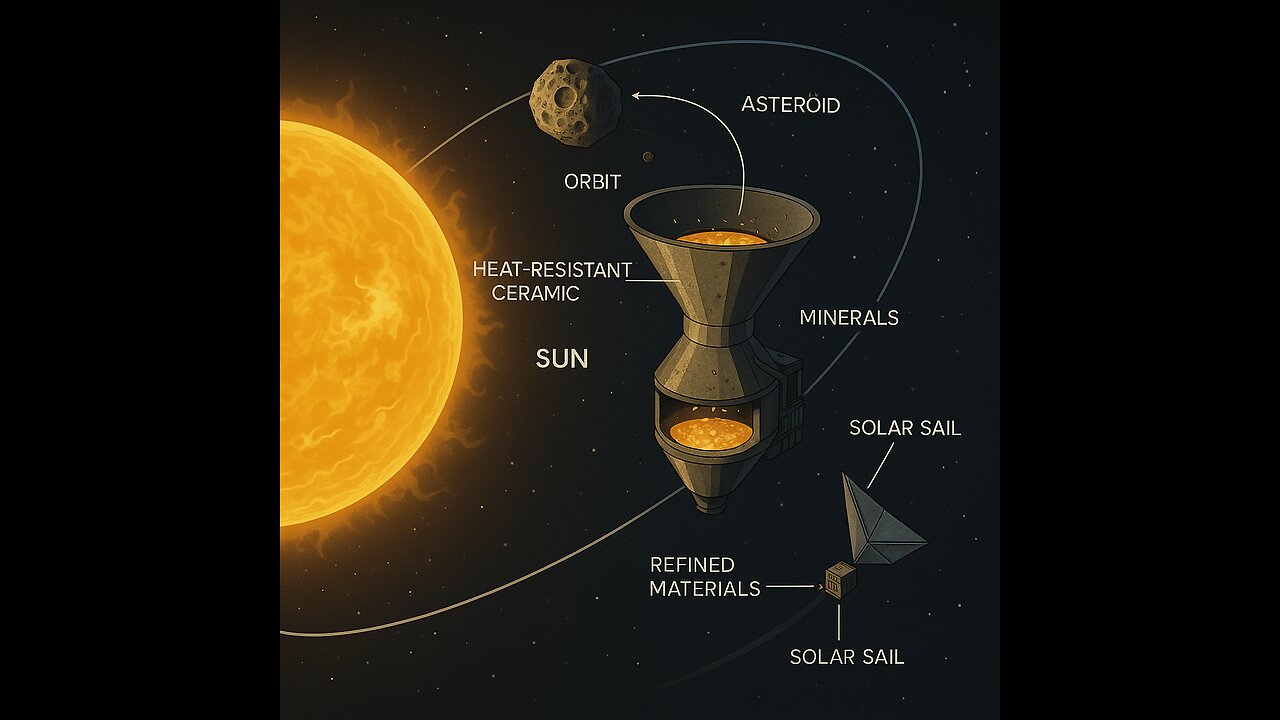Premium Only Content

Forging the Future Among the Stars
Conceptual Overview: Solar-Orbit Asteroid Refinery System
This illustration depicts a conceptual model for in-situ asteroid resource extraction via orbital thermal processing near the Sun. The system utilizes gravitational dynamics, radiative flux, and material phase transitions to enable automated mining and return of refined resources.
Key Elements:
1. Elliptical Asteroid Orbit:
The asteroid is shown in a highly elliptical solar orbit. The point of interest is near aphelion, where its orbital velocity is at a minimum (per Kepler's Second Law), allowing for more efficient interception and capture operations.
2. Solar Proximity Furnace ("The Funnel"):
Positioned in close solar orbit, the ceramic-structured refining station leverages extreme solar irradiance to induce volatile release and partial liquefaction of the asteroid's surface. The structure is composed of ultra-high-temperature ceramics (e.g., zirconia composites) capable of withstanding radiative loads exceeding 2,000 K.
3. Mineral Capture and Refinement:
Sublimated and molten minerals are collected through centrifugal and capillary-action mechanisms embedded within the funnel's geometry. Volatiles may be separated and stored for in-situ propulsion or fuel cell applications.
4. Solar Sail Return Modules:
After mineral separation, refined payloads are packaged into autonomous cargo units equipped with solar sails. These units use photon pressure for trajectory control and are directed toward orbital construction yards, Lagrange points, or Earth-Moon system depots.
5. Autonomous System Design:
The entire operation is designed for full automation, potentially governed by decentralized AI control systems for target selection, orbital adjustment, thermal load management, and logistics routing.
Strategic Implications:
This architecture proposes a dual-use potential: enabling large-scale extraterrestrial material harvesting while inherently containing planetary defense mechanisms by rerouting potentially hazardous objects into controlled decay or processing trajectories. The controlled orbital insertion technology required presents a critical area for ethical oversight and international cooperation.
-
 1:05:18
1:05:18
Steve-O's Wild Ride! Podcast
3 days ago $1.48 earnedYUNGBLUD Stands Up For His Generation | Wild Ride #265
23.6K4 -
 8:18
8:18
MattMorseTV
13 hours ago $7.35 earned2.2 MILLION in ONE YEAR.
58.8K138 -
 12:11
12:11
Nikko Ortiz
2 days agoCrashout 6 Rumble
82K8 -
 19:56
19:56
GritsGG
14 hours agoSpectating Random Solo Players in a Bot Lobby!
4.76K1 -
 LIVE
LIVE
Lofi Girl
2 years agoSynthwave Radio 🌌 - beats to chill/game to
351 watching -
 16:22
16:22
BlabberingCollector
2 days agoHarry Potter HBO: Addressing Some New Rumors!
4.57K2 -
 4:01:30
4:01:30
Badlands Media
21 hours agoThe Narrative Ep. 37: The Sovereign War
178K34 -
 11:23:54
11:23:54
SpartakusLIVE
14 hours agoMega SOLO Spartan Stream - 12 hours?! HA || Variety Later?!
106K -
 4:55:23
4:55:23
Rallied
7 hours ago $20.35 earnedSolo Warzone Challenges All Night
50.3K3 -
 4:53:38
4:53:38
Due Dissidence
17 hours agoTaibbi DEFENDS Weiss-CBS Deal, Pakman Producer SPILLS TEA, Massie CALLS OUT Trump Informant Claims
33.2K42